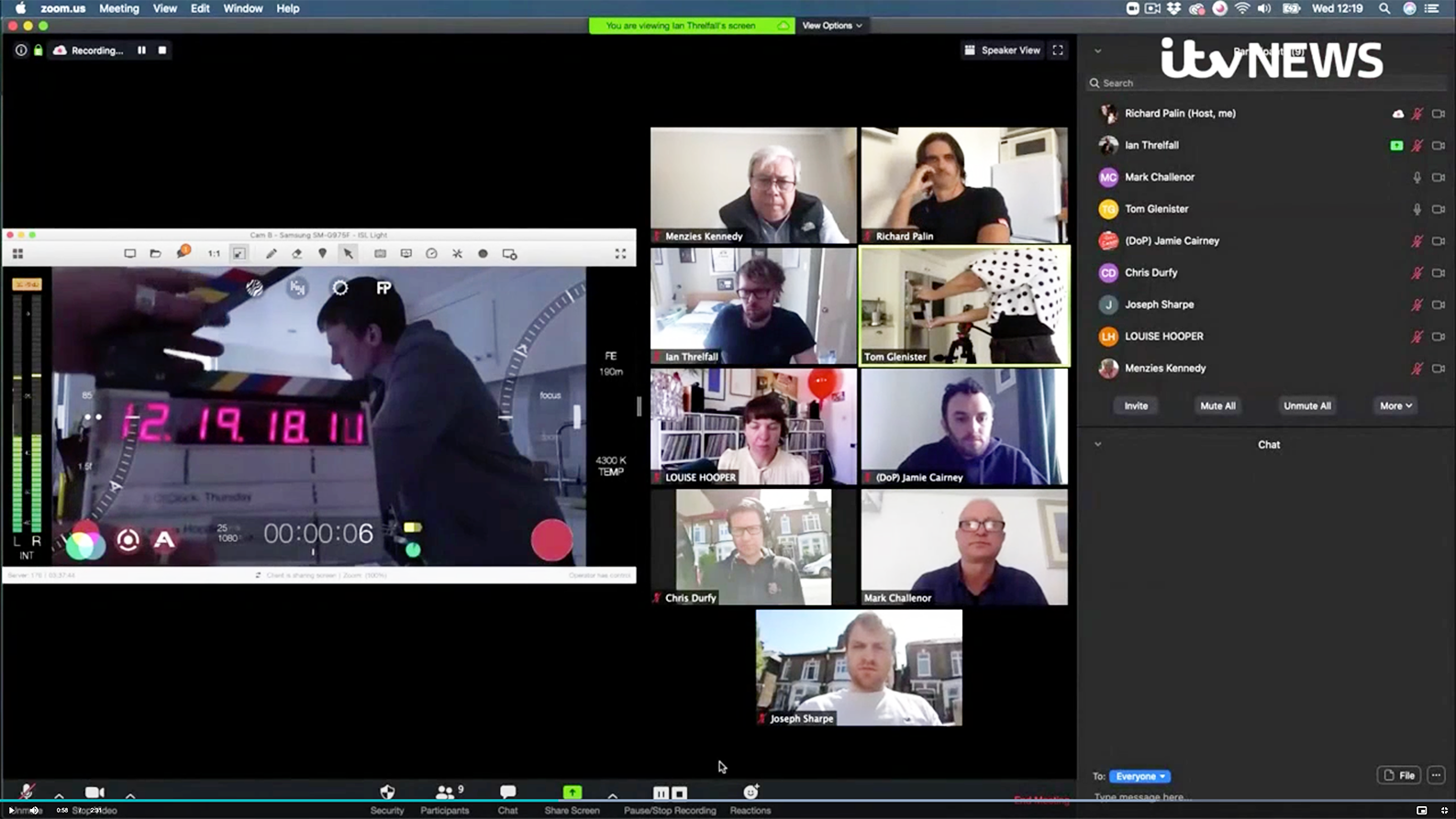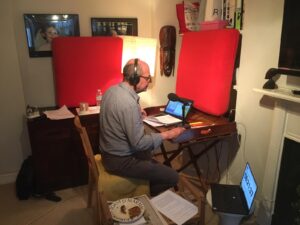Beating the virus – how broadcast production has responded

As the global pandemic continues, broadcasters and production companies have had to find new ways of working to ensure that programmes can still be made. At the same time they are looking to the future to ensure that output can be maintained as the virus persists in posing a threat to people’s health. The AIB takes a look at some of the solutions broadcasters have adopted and at the way production guidelines for the coronavirus era are being developed. We’re focusing on the UK for much of this article; if you’d like to share experiences from other parts of the world, please do send us your stories: editorial [@] aib.org.uk.
 The need to provide safe working environments for staff has led to innovation in production techniques for both live and recorded shows. In radio, many presenters are working from home, contributing via IP-based systems from makeshift studios in front rooms, studies and basements, with clever use of home furnishings to provide sound deadening (our picture shows Nick Robinson, one of the presenters of BBC Radio 4’s Today current affairs programme, in his home). Presenters have come to realise that working from home can be good (access to one’s own kitchen is a particular benefit), but have had to adapt to cope with the arrival of refuse collectors who can be clearly heard through windows and dogs and children that demand attention. These are distractions that simply don’t exist in the usual studio environment. Occasional drops in Internet connections have also proved challenges with other presenters having to cover as links stubbornly refuse to connect. One BBC Radio 3 presenter due on air from home at 0900 was all set to go live when his router decided to disconnect from the Internet. After much shouting, swearing and cursing, he decided the only thing to do would be to dash from his home in North London to Broadcasting House to fire up a studio there to get on air, all the while ensuring social distancing was maintained. Definitely dedication, but perhaps not so good for the heart
The need to provide safe working environments for staff has led to innovation in production techniques for both live and recorded shows. In radio, many presenters are working from home, contributing via IP-based systems from makeshift studios in front rooms, studies and basements, with clever use of home furnishings to provide sound deadening (our picture shows Nick Robinson, one of the presenters of BBC Radio 4’s Today current affairs programme, in his home). Presenters have come to realise that working from home can be good (access to one’s own kitchen is a particular benefit), but have had to adapt to cope with the arrival of refuse collectors who can be clearly heard through windows and dogs and children that demand attention. These are distractions that simply don’t exist in the usual studio environment. Occasional drops in Internet connections have also proved challenges with other presenters having to cover as links stubbornly refuse to connect. One BBC Radio 3 presenter due on air from home at 0900 was all set to go live when his router decided to disconnect from the Internet. After much shouting, swearing and cursing, he decided the only thing to do would be to dash from his home in North London to Broadcasting House to fire up a studio there to get on air, all the while ensuring social distancing was maintained. Definitely dedication, but perhaps not so good for the heart
It can be argued that radio is better placed to instigate remote production than TV. That has not stopped TV broadcasters from innovating successfully, with complex productions moved from broadcast studios into the homes of staff across the country. One example is BT Sport. It has developed a production system that has staff working from home in all parts of the country. From audio in a garage to an EVS operator in his front room and presenters building make-shift studios in their homes, the system harnesses VMix – a system developed by an Australian software company – to bring the production team and all remote sources together. You can see a short video about the way the system works above.
 VMix is also being used by AIB Member BlackRook Media for production of factual programmes for a number of its clients. They have developed a demonstration programme that can be seen here and the system has been deployed for a range of live programmes around the world.
VMix is also being used by AIB Member BlackRook Media for production of factual programmes for a number of its clients. They have developed a demonstration programme that can be seen here and the system has been deployed for a range of live programmes around the world.
Inevitably with programmes that rely on contributions over the public Internet there can be problems. Audio goes out of sync and video quality can suddenly fall and in the worst case, the contributor’s link fails altogether. This means that producers must have contingency plans in place and flexible scripts to allow for these drop-outs to be covered, particularly in live programmes. Of course, these problems can occur in the gallery in studio complexes when outside sources suddenly disappear but it’s less common than faults that develop in the current environment when broadcasters are relying on home routers and Internet connections that can be throttled by ISPs.
This level of innovation demonstrates what is possible in challenging circumstances and the viewing and listening public is becoming more tolerant of on-air problems as an increasing number of broadcasters turn to new ways of producing output.
Moving beyond lockdown
 As, thankfully, the number of COVID-19 cases starts to decrease in many countries, the media industry is looking for ways to return to some level of normality. In Germany, football matches kicked off for the first time in many weeks over the weekend of 16/17 May, albeit played behind closed doors with no more than 300 people allowed into the stadia. Broadcasters were able to take the first matches with OB trucks deployed, with extensive social distancing in place using perspex screens between individual production teams’ positions and a reduced number of staff in the trucks (see photo, via SVG Europe).
As, thankfully, the number of COVID-19 cases starts to decrease in many countries, the media industry is looking for ways to return to some level of normality. In Germany, football matches kicked off for the first time in many weeks over the weekend of 16/17 May, albeit played behind closed doors with no more than 300 people allowed into the stadia. Broadcasters were able to take the first matches with OB trucks deployed, with extensive social distancing in place using perspex screens between individual production teams’ positions and a reduced number of staff in the trucks (see photo, via SVG Europe).
The German football leagues published an extensive health and safety document setting out the rules for everyone involved in matches, from players to broadcasters. Pages 30-37 of the document set out the way OB units would need to function with extensive social distancing. The measures included in this document show how any live broadcast needs to be operated in the new era and can be employed equally well in studio production areas as well as OB trucks.
In the UK, broadcasters published guidelines on 18 May for how productions need to cope with the challenges of coronavirus. These set out six areas that need to be considered for productions during COVID-19, including:
- Specifically consider people at higher risk of harm
- Heighten precautions for everyone at work
- Reduce the number of people involved
- Consider editorial ‘on camera’ requirements
- Consider mental health and wellbeing
- Feedback loop
The protocols also set out key points for assessing risk or considering controls, including travel, working patterns, equipment, first aid and mental health.
Tony Hall, BBC Director-General, said:
Everyone across the TV industry wants to get production back up and running. Recent weeks have shown just how important shows are to the public. But we can only move forward with the right safety measures in place. This guidance is an attempt to get that right. Clearly we will keep it under review. We have, as an industry, already learnt a lot about how we can deliver programmes and we will all put that into practice.
Gary Davey, CEO Sky Studios, said:
This guidance provides production companies and broadcasters with a shared set of principles to keep staff, cast and crew safe across a range of productions. We will continue to work closely with our international partners, share best-practice and continuously review and evolve the guidelines as we return to production.
Anna Mallett, CEO, ITN said:
Our teams in ITN have pioneered new ways of working to keep the news on-air and crucially, to keep staff, freelancers and contributors safe during this time.
We’ve been able to share our experiences and protocols to help draw up these guidelines for the wider industry. Our documentary team have found ways to ensure safety and creatively maintain production on a number of programmes filmed in contributors’ homes and on location.
The UK Secretary of State for Digital, Culture, Media and Sport, Oliver Dowden, said:
Great British television is keeping us company throughout the crisis, and I’m keen to get cameras rolling as soon as it is safe to do so. This is a significant step forward in getting our favourite shows and soaps going again.
Our creative industries are Britain’s global calling card, and I want to see them get back to doing what they do best safely.
AIB supporting its Members
The Association for International Broadcasting has been supporting its Members throughout the pandemic, producing one of the earliest briefings for broadcasters on the situation and implementing a WhatsApp information exchange for Members to share intelligence and ask questions of one another. The AIB will continue to assist its Members in these challenging times on issues around coronavirus while maintaining its work on all other areas that help its Members operate across the world.
Main image: ITV News report on filming of four-part drama series Isolation Stories
